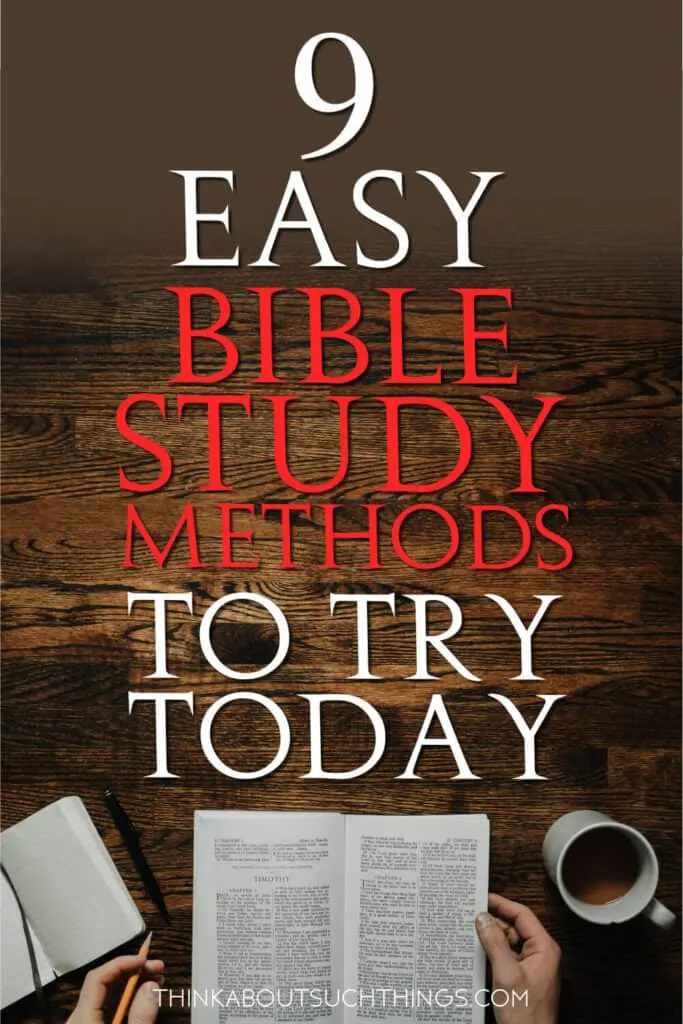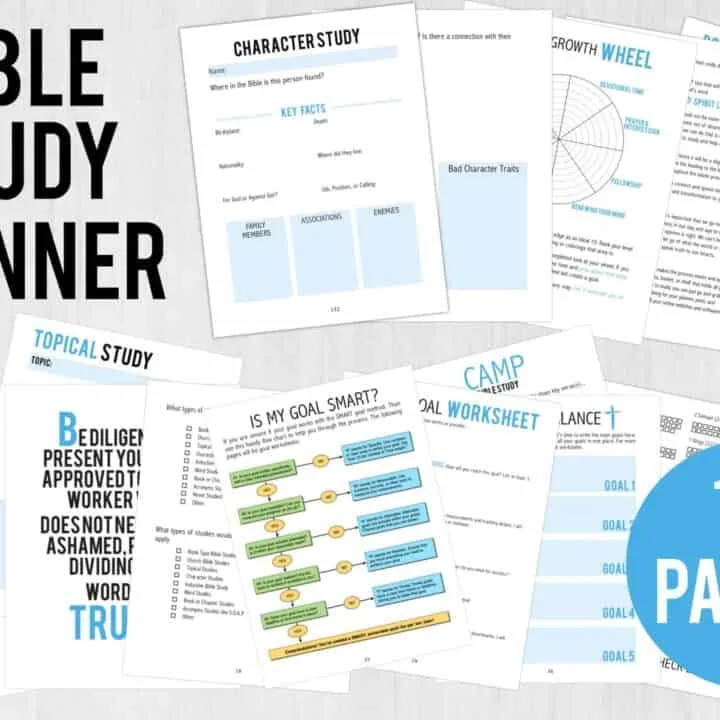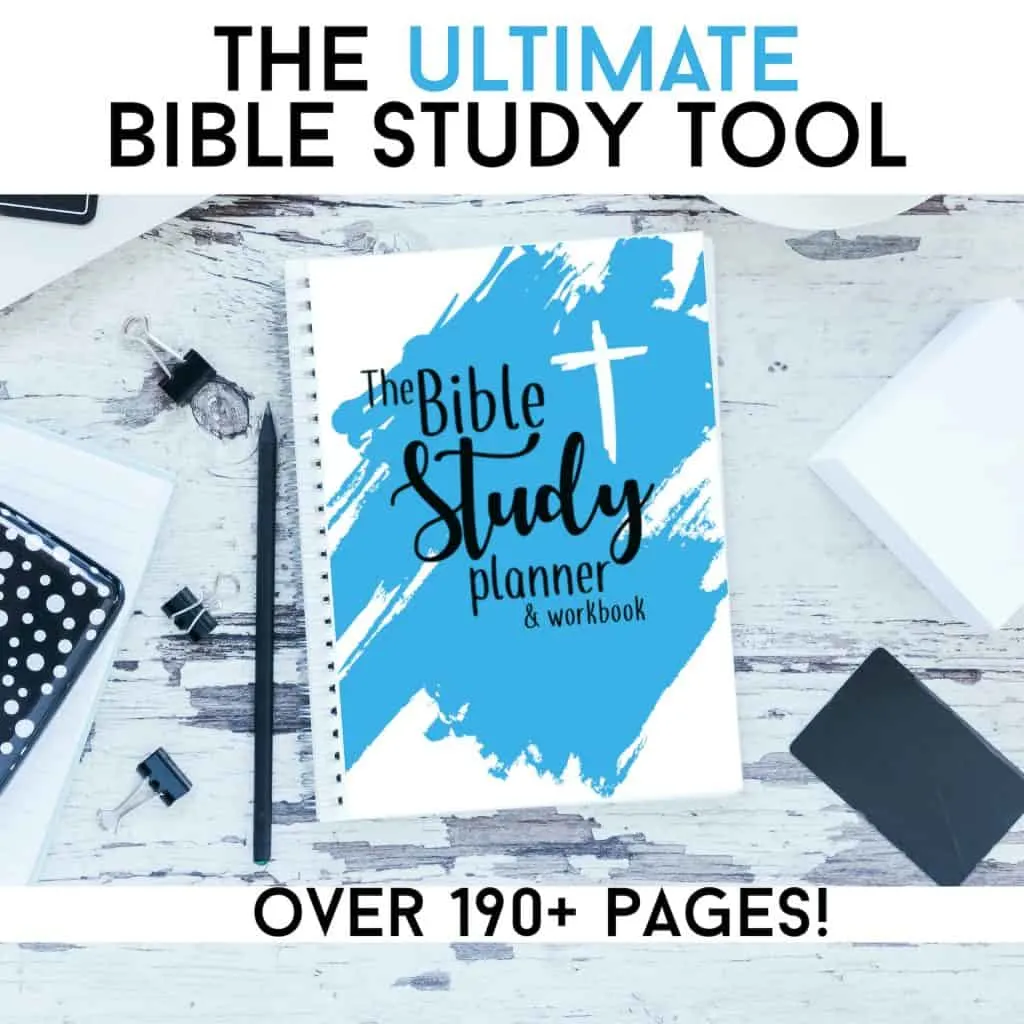Learn how you can dive into scripture with these 9 Bible Study methods. Each Bible study how-to can easily be applied to your time in God’s Word.

Studying the Bible can be such an incredible and fulfilling activity. It can transform us and draw us closer to God. But sometimes we can feel hesitant to study the Bible. We either feel underequipped, fearful, or insecure.
And that’s exactly what the enemy wants you to think! The truth is you can study the Bible with the best of them! Because you have the Holy Spirit within you! The methods below will just make it easier for you by giving you step-by-step instructions.
I hope this post is an encouragement and a blessing to dig deeper and learn how to study the Bible personally at home.
Tools to Help You With Your Bible Study Methods

I cover this topic of Bible study tools extensively in these three posts below. I encourage you to check them out, otherwise, I briefly go over a few here in this post. I want to keep it simple. Studying the Bible doesn’t have to be daunting…it can be easy, effective, and fun!
Prayer
No matter the Bible study method you decide to do…the number 1 thing of importance in prayer. This is a time for you to connect with Holy Spirit and ask Him to guide, reveal, and transform you as you study His word. Pray before you start, talk to Him in between, and finish off in prayer.
Bible Dictionary, Commentaries, and Concordances
If you really want to get the most out of your Bible study time then I recommend purchasing or using free resources online to help you go deeper. The basic three I recommend are:
A Good Set of Pens and a Journal
As you study the Bible you will need somewhere to write your notes. You can do this digitally or in a journal. I personally prefer a journal. I love the ability to touch and there is the benefit of better memory retention. (source) Here are some of my favorite pens to use in Bible studying.
Effective Bible Study Methods

We will be going over 9 personal Bible study methods and all the steps needed to complete them. You can go as creative or simple as you like with the way you study.
I personally bounce back and forth. Sometimes I have a black pen and my journal and other times I have every colored pen you can imagine. Remember, to do you…. have fun and spend time in His Presence and Word.
Inductive Bible Study Method
The inductive Bible study method may sound hard but it’s actually very easy and can be so fruitful. It’s basically 3 steps. And it can be used for small portions of scripture or larger portions.
- Observation
- Interpretation
- Application
Observation
WHAT DOES THE TEXT SAY?
This all about noticing important facts in the scripture. A fun and easy way we can do that is by answering the five W’s and H. Yes, the ones you used to do in school projects and reports!
Here is an example:
- Who? – What people are mentioned in these passages? Who is the main character in the verses? Who wrote this book?Who is the text written to?
- What? – What has happened in the passage? What type of literary style does it fall into (prophetic, historical, poetry…etc)?
- Where? – Where does this Bible story take place? Any specific locations or landmarks?
- When? – When was this written? Was it during the Roman empire?
- Why? – Why did things happen the way they did in the Bible passage?
- How? – How did we get from point A to B? How did the main character keep his faith?
I would encourage you not to stop at just the five W’s and H. Also, make a special note if there are repetitive words, things that you could list (like the fruit of the Spirit), or anything that really stands out to you!
Interpretation
WHAT DOES THE TEXT MEAN?
After you have finished your observation it’s time to see what the passage means. In this step you want to try to figure out what was the author trying to show us.
This is a great opportunity to pull out some Bible tools. They can help you understand what the text is saying.
Things you want to look up…
- The cultural and historical context.
- The background of the Biblical book.
- Supporting texts or cross references
Try not to rush this step. You really want to dig deep and discover what the Word is saying.
Application
WHAT DOES THIS TEXT MEAN FOR ME?
Now, that the interpretation step has been completed it’s time to ask, “how do I apply what we just learned to my life?” Reflect back through everything and spend time in prayer. Ask the Lord to highlight and speak to your heart.
I also encourage you to jot down notes in this step as well.
Acronym Bible Study Method
Acronyms can be a really fun Bible study method! Just in case you are not familiar with what an acronym is…
“a word formed from the initial letters or groups of letters of words in a set phrase or series of words and pronounced as a separate word, as Wac from Women’s Army Corps, OPEC from Organization of Petroleum Exporting Countries, or loran from long-range navigation.” (Dictionary.com)
We will look at two different Bible study acronyms. One of the most popular ones is called S.O.A.P.
S.O.A.P BIBLE STUDY
In this Bible study method, you will complete 4 easy steps. Below is a quick version of how to do the SOAP study. For a more robust how-to and free SOAP printable please visit: The SOAP Bible Study Method Done Easy
Step 1 – S is for Scripture
Pick a verse or two
Step 2 – O is for Observation
What stood out to you?
Step 3 – A is for Application
How do apply this to my life?
Step 4 – P is for Prayer
End your study time in prayer.
J.U.M.P BIBLE STUDY
JUMP is an acronym study I created for my Bible Study Planner.
Step 1 – J is for Jot it down
Find a verse(s) and write them down.
Step 2 – U is for Use a Bible Commentary
Find a Bible Commentary or two on the verse(s) you picked. Write down what you learned.
Step 3 – M is for Meditate
Take some quiet time and meditate on those verses and what you have learned. A simple way to meditate on scripture is to read it slowly out loud and wait on God’s presence as you read.
Step 4 – P is for Prayer
End your study time in prayer. You can also write out your prayer if you like.
Theme Bible Study Method
A themed Bible study or a thematic study method is when you choose a theme within scripture and study around it. An example would be to study the theme of restoration within the book of Ezra.
Here are some quick steps to get you started:
STEP 1 – CHOOSE A THEME
If you are new to this kind of study method then I encourage you to choose a theme that is simple or keep the study within a certain amount of chapters or books in the Bible.
STEP 2 – CHOOSE WHERE TO STUDY
Most thematic studies are done within a portion of scripture. For broader studies you would then to a topical study. So, choose your theme and choose where you would like it. For my example above you could do a themed study in Ezra about restoration since it’s a central theme within the book, but the same could be said about the book of Job. You could focus on one or both books. Another way to go about it is to just focus on key chapters.
Now, make a list of verses and Biblical stories you intend to use in your study. You want these to be verses that really hit your theme.
STEP 3 – CREATE A LIST OF QUESTIONS
In this step, you want to get your creative juices going. Think of questions you have regarding this theme. Try to think of at least 5 or more questions.
Here is an example on the theme of restoration:
- How did restoration impact Ezra’s/Job’s faith?
- What does restoration teach me about the character of God?
- What are the biggest things that stood out to me?
- What are things that hindered restoration from taking place?
- Was there key things that took place that ushered in restoration?
STEP 4 – START READING AND GRAB YOUR STUDY TOOLS
Start reading over those verses on your list and asking those questions you have written down. Use Bible dictionaries, concordances, and commentaries to deepen your understanding. Try to answer all your questions.
Make sure to write down your answers and additional notes. You can use paper or something digital.
STEP 5 – PERSONAL APPLICATION
At the end of your study jot down how you can apply what you have learned in your study. This can be a short summarization and I encourage you to take some time in prayer and discuss with the Lord what you have learned. Ask Him to help you to apply all you have learned.
Jim and Elizabeth George have a great printable of One-Word Themes for All the Books of the Bible. Head over there and check it out!
Topical Bible Study Method
A topical Bible study is much like a themed study on a much larger and robust scale. You can take any topic within scripture and do an exhaustive study. This is one of my favorite ways to study and because of that, it has its own stand-alone post. This post will give you all the details you need to rock a topical bible study. Just click the link below:
>> Click Here for the Topical Bible Study: An Easy How-To Guide To Get You Started
Word Studies
Topical studies are probably my favorite Bible study method, but Word Studies is right up there!
This is where you take one word in scripture and dive in deep into the original language and learn everything you can about that word.
To do this kind of study you will have to use a concordance. You can purchase one like on Amazon on use one online (Online Option).

Here are a few key things to do while doing a Word Study:
- Jot down key verses and other references that use the word.
- Look at the definition in Hebrew, Greek and even the modern dictionary.
- Check out Bible dictionaries and commentaries
Bible Character Studies
>> Click here for an in-depth How-To Guide on How to Study Bible Characters
A Bible character study is when you focus on one specific person in the Word. The purpose of this is to learn from their life story, their strengths, weaknesses, victories, mistakes, and more.
When doing a character it’s important that you read the life story of the character and any other references there are on him/her. Make note of important facts like:
- Birthplace
- Where did they live
- Job, Postion, and/or Calling
- Nationality
- Family Members
- Enemies
- Key Life Events
- Etc…
After that started to dig deeper. I would encourage you to use Bible study tools. Some things to look for are:
- What does their name mean?
- What was some of their good character traits?
- What was some of their bad character traits?
- Did their character change over time?
- How did God use them?
- Etc…
There are lots of ways to do a character study. Sometimes I like to get super creative with it. This is a character study I did on Samson and Delilah.
Chapter Studies
A chapter study is exactly as it states. It’s studying one chapter out of the Bible. There are many ways you can go about doing a chapter study, but here is a simple way you can give it a try.
STEP 1 – READ
Read the chapter 3-4 times. If possible try to read it in different versions of the Bible. Read through cross references within the chapter.
Ask the Lord to give you insight as you study.
STEP 2 – BREAK THINGS DOWN
Write down words that you don’t understand or want to understand better. Use a Bible dictionary and/or Bible concordance to understand these words better.
STEP 3 – FIND KEY VERSES(S)
Try to find one or two verses that seem to sum up the chapter. Write these verses down
STEP 4 – WHAT STOOD OUT TO YOU?
Write down a verse that stood out to you or that you feel like the Lord is highlighting. Make note of why that verse is speaking to you.
STEP 5 – HOW DO I APPLY?
This is a time of prayer and reflection. Ask the Lord to speak to your heart on how you can apply what you learned. Write down what you are sensing.
Verse by Verse Bible Study Method
Verse by Verse is much like a chapter study except you will be focusing on a section of verse. This could be anything from a few Bible verses to wanting to study a whole book verse by verse.
STEP 1 – SELECT A PASSAGE
Find a passage in scripture with at least a few verses.
STEP 2 – READ AND TAKE NOTE
Read through the verses a couple of times. Don’t be in a hurry in this step. It’s important to grasp what is being said. Make note of anything stands out to you or that you find interesting. This is a good time to write down any names, locations, and things that pop up.
STEP 3 – START RESEARCHING
Grab a Bible dictionary, commentary, concordance or other Bible study tools. Camp on one verse at a time. Write down anything that stood out to you. Don’t proceed to the next verse till you feel like you have a good grasp on it.
STEP 4 – APPLICATION
Once you have gone verse by verse take a moment to pray and talk to the Lord about what you have learned. Afterward, write down how you can apply what you learned to your everyday life.
Verse Mapping
Verse mapping is taking a verse and mapping out all it has for you. Kind of like mind mapping but with the Bible! This can get really creative or you can keep it simple and straightforward.
I really enjoy Kristy Cambron’s way of going about verse mapping. She recently even came out with a Verse Mapping Bible Study Journal. But there are many ways you can go about verse mapping.
Here is a simple way to do verse mapping.
STEP 1 – SELECT YOUR VERSE
This can be a verse you feel like the Lord is speaking to you about or one you want to go deeper into.
STEP 2 – WRITE THE VERSE OUT
You can go about this in a couple of ways… 1) write the verse in the middle of the page or 2) at the very top of the page. It all depends on how you want to construct your “map.”
Highlight or underline and keywords of phrases that stand out to you. You can even get creative and circle or place boxes around these words.
STEP 3 – RESEARCH
Grab those handy dandy Bible tools! Now, it’s time to look up all those things you highlighted and underline. Make sure to look up the Hebrew/Greek definitions and other translations too. Lots of gold nuggets there! Write all that stuff out on your paper connecting it with the verse.
STEP 4 – RELEVANCE
In your final step, you are going to be asking,
- What is God saying to me?
- How is this relevant to me?
- How can apply this verse to my life?
I encourage you to write a few personal sentences of what you have learned. Almost like a summary of sorts.
The Bible Study Planner
If you would like to try a lot of these methods out but want a template to help you along. I have created a Bible Study Planner and Workbook. It has many of the same Bible techniques and methods above and more.
This is a printable which means you can print as many of these planners as you like and never run out of templates! You can learn more about it here: The Bible Study Planner & Workbook or purchase it below
Before I close this post I wanted to recap on the 9 different methods of Bible study that I have shared.
- Inductive Bible Study Method – A 3 step method that involves, observation, interpretation, and application.
- Acronym Bible Study Method – Using acronyms to break down ways you can study the Bible.
- Theme Bible Study Method – Finding a theme within scripture to study.
- Topical Bible Study Method – An extensive study on one given topic.
- Word Studies – The study of a word found in scripture.
- Bible Character Studies – The study of a specific Bible character found in the Bible.
- Chapter Studies – Studying a specific chapter within the Bible to get a better understanding.
- Verse by Verse Bible Study Method – A slower paced way to go verse by verse and study in depth.
- Verse Mapping – Usually a creative way to study scripture by creating a map similar to a mind map that is centered on a key verse.
If this post has blessed you or if you would like to share a different method or Bible study techniques….PLEASE share below! We can all learn from each other.

Melissa is a passionate minister, speaker and an ongoing learner of the Bible. She has been involved in church and vocational ministry for over 18 years. And is the founder of Think About Such Things. She has the heart to equip the saints by helping them get into the Word of God and fall more in love with Jesus. She also enjoys family, cooking, and reading.
She has spoken in churches in California, Oregon, Texas, and Mexico and has been featured in Guidepost Magazine and All Recipes Magazine. Read More…







